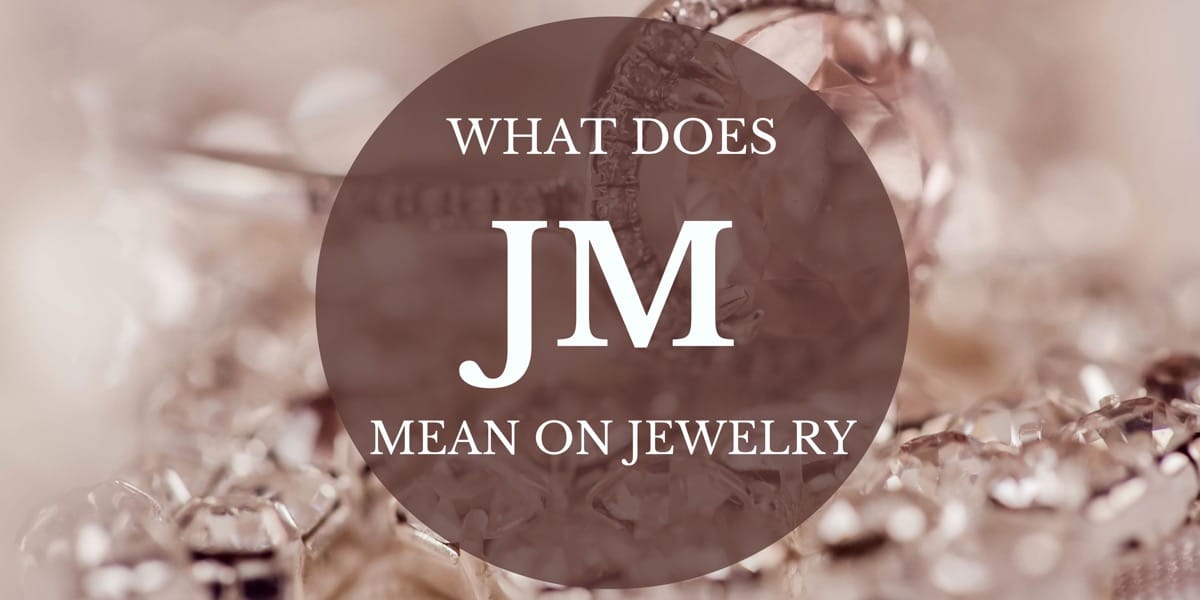Jewelry, beyond its aesthetic appeal, often holds hidden stories and clues within its markings. One such intriguing mystery is the enigmatic “JM” inscription found on various pieces. If you’ve ever encountered this symbol and pondered its significance, fret no more! This detailed guide delves into the fascinating world of jewelry markings, deciphering the potential meanings behind “JM” and empowering you to appreciate your jewelry on a deeper level.
Unveiling the Possibilities
While there’s no one-size-fits-all answer to “What does JM mean on jewelry?”, several possibilities stand out:
- Designer or Maker’s Mark: Often, “JM” represents the initials of the artist or company responsible for creating the piece. This is a common practice among independent designers and smaller studios, adding a personal touch and establishing brand identity. To unravel this mystery, research known jewelry designers or manufacturers whose initials match “JM.” Consult online resources, vintage jewelry forums, or seek assistance from antique jewelry experts.
- Metal Hallmark: In some cases, “JM” might be a hallmark indicating the metal type and origin. Hallmarks are tiny stamps applied to precious metals like gold or silver, denoting their purity and country of origin. To understand the meaning of “JM” as a hallmark, you’ll need to consider the accompanying symbols or letters. For instance, “JM” combined with a lion symbol could indicate British 9 carat gold. Research international hallmarking systems and their symbols to decipher the specific meaning for your piece.
- Custom Engraving: “JM” could also be a personalized engraving, holding sentimental value for the owner. Initials, dates, or even short messages are commonly engraved on jewelry to commemorate special occasions or honor loved ones. If you have inherited the piece or received it as a gift, inquire about its history or any inscriptions that might hold personal significance.
- Other Meanings: In rarer cases, “JM” might represent something entirely different, specific to a particular brand, style, or cultural context. Consider the overall design, origin, and any accompanying markings to glean further clues. Consulting experts specializing in that specific jewelry style or culture might be necessary.
Beyond the Markings
Remember, the true value of your jewelry lies beyond the markings. Consider these additional factors to appreciate your piece fully:
- Design and Craftsmanship: The overall design, materials used, and level of craftsmanship speak volumes about the piece’s quality and artistic merit. Appreciate the intricate details, unique features, and the skill involved in its creation.
- Personal Connection: Does the piece hold any sentimental value or personal significance for you? How did you acquire it, and what memories does it evoke? These emotional connections add depth and meaning to your jewelry, transcending any markings.
- Historical Context: Research the piece’s era, style, and cultural influences. Understanding its historical context enriches your appreciation and allows you to see it as a window into a bygone era.
Embrace the Journey
Unraveling the mystery of “JM” on your jewelry is a journey of discovery, adding a layer of intrigue and personalization to your precious possessions. Remember, the true value lies not just in the markings, but in the design, craftsmanship, personal connection, and historical context. So, embark on this exciting exploration, appreciate your jewelry on a deeper level, and let its story unfold before you.
Additional Tips
- When researching designer or maker information, pay attention to variations in font styles and accompanying symbols, as similar-looking markings can represent different entities.
- Online forums and communities dedicated to vintage jewelry or specific design styles can be valuable resources for identification and historical context.
- For valuable or sentimental pieces, consider consulting professional gemologists or appraisers for a more comprehensive evaluation and historical analysis.
By following these tips and delving into the fascinating world of jewelry markings, you’ll transform your “JM” mystery into a cherished part of your jewelry’s unique story.
Expanding the Scope
- Regional Variations: Mention that the meaning of “JM” can vary depending on the region where the jewelry was made or sold. Include examples of specific countries or regions where “JM” might have a particular meaning associated with metal hallmarks or cultural symbolism.
- Vintage vs. Modern Jewelry: Briefly discuss the differences in how “JM” is used on vintage versus modern pieces. For example, vintage jewelry might be more likely to have personalized engravings, while modern pieces might utilize “JM” as part of a designer’s logo or brand identity.
- Online Resources: Provide a list of helpful online resources for further research, such as online jewelry identification databases, vintage jewelry forums, and websites of specific designers or manufacturers known to use “JM.”
Examples and Case Studies
- Include real-life examples: Showcase a few specific cases where “JM” has been identified on different types of jewelry (e.g., a vintage ring with “JM” and a lion symbol, a modern necklace with “JM” as part of a designer’s logo). Briefly explain the meaning of “JM” in each case, based on research and available information.
- Consider user-submitted stories: Encourage readers to share their own experiences with “JM” on their jewelry and how they unraveled the mystery. This can add a personal touch and create a sense of community around the topic.
Visuals and Engagement
- High-quality images: Include clear and engaging images of jewelry with “JM” markings throughout the post. This will help readers visualize the different scenarios and styles discussed.
- Interactive elements: Consider incorporating interactive elements like quizzes or polls to engage readers and test their knowledge about jewelry markings.
Ethical Considerations
- Respect privacy: If sharing user-submitted stories, ensure you have their permission and avoid disclosing any personal information.
- Accuracy and attribution: Cite your sources appropriately when providing information on designers, hallmarks, and historical context.

